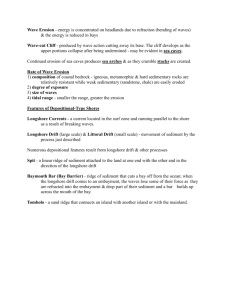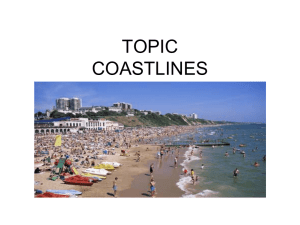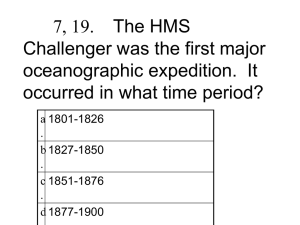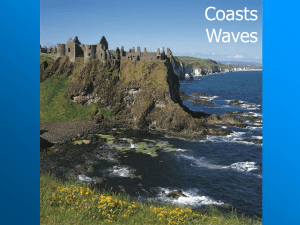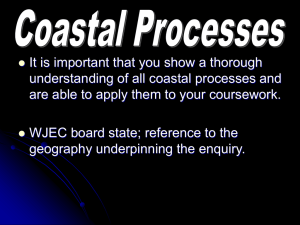Lesson 2: Coastal Landforms
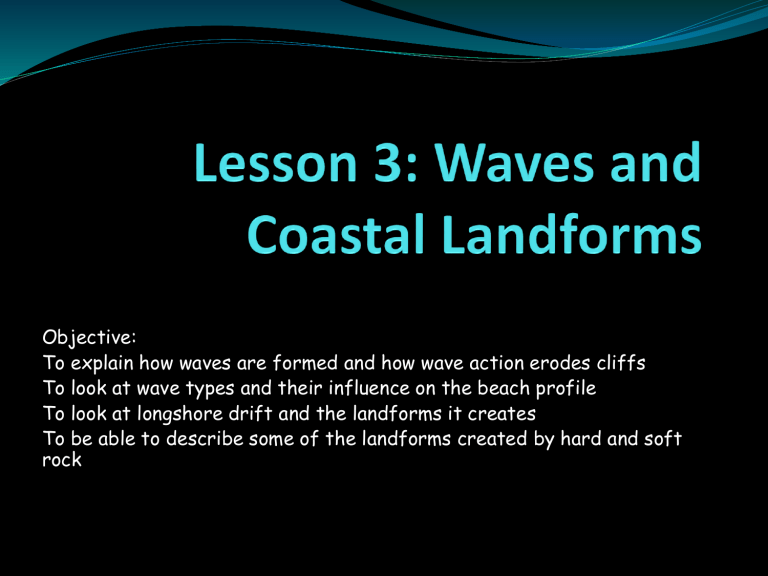
Objective:
To explain how waves are formed and how wave action erodes cliffs
To look at wave types and their influence on the beach profile
To look at longshore drift and the landforms it creates
To be able to describe some of the landforms created by hard and soft rock
MARINE EROSION (cliff foot) Erosion is the process of wearing away and breaking down rocks.
Abrasion – the waves throw pebbles and rocks against the cliffs, wearing them away
Attrition – the pebbles and rocks are worn away as they crash against each other.
Solution – the water itself is slightly acidic and can dissolve minerals such as calcium carbonate, which is in chalk and limestone.
Hydraulic Action – the force of waves traps air in cracks …air pressure breaks off pieces of rock…
How else can we remember these?
Starter
Which type of marine erosion goes with these definitions.
1. When rock fragments grind and bash into each other down into smaller smoother pebbles, shingle and finally sand which is later deposited as beaches.
2. Is cause by broken rock fragments battering the land, cliffs etc. and breaking off other pieces of rock.
3. Involves chemical action of sea on rock.
If the rock is limestone, it dissolves in the sea-water – some sea salts can also react with certain rocks and cause them to rot.
4. Lots of sea water crashes against the land, and air and water are trapped and compressed in rock surface cracks. When the sea moves away again, the air expands explosively weakening the rocks, enlarging the cracks and breaking pieces off.
Waves and the Coastlines
Waves are constant
Waves have three affects on the coast
They cause Erosion
They Deposit eroded material
They Transport eroded material
Waves
The height of the waves depend on how long and far the wind has been blowing over the sea and how strong it is. This is called the fetch
What happens below the water as waves move?
What happens when waves reach the coast?
Wave Types
We know what waves can do to the cliffs but did you know that there are 2 different types of waves and they can BUILD or DESTROY beaches.
Destructive waves these destroy beaches by taking away the sediment- also known as winter waves
Constructive waves these build beaches by depositing sediment on the beach- also known as summer waves
Task
You will need to understand how waves are formed and effect the coastline.
Answer the questions below to check your understanding of this.
1. The sea causes three processes to occur on the coastline, name these and give a description of each.
2. What are the three characteristics that effect the size of a wave?
3. Explain the difference between swash and backwash.
4. Explain how constructive waves construct coastline and destructive waves destroy it.
5. Complete the activity ‘Your questions’-page 77 GCSE Geography.
Landforms at the Coast
Marine and Sub-Ariel erosion cause several landforms and erosional features at the coast.
Headlands and Bays
Caves, arches, stacks and stumps
Cliff slumping
Wave cut notches and platforms
Longshore drift creates depositional landforms
Headland and Bay formation
Caves, arches, stacks and stumps
Source: http://www.geography.learnontheinternet.co.uk/topics/waves.html
Durdle Door- How was it formed?
What is the influence of joints and faults on this landform?
Wave-cut notch and platform
Wave-cut notch and platform
Wave cut platform
Task: Make a copy of this diagram in your book, remember to include a title.
1
3
2
5
6
7
4
Longshore Drift- process of deposition and transportation
Let’s try the Long
Shore Drift dance
Up the beach at an angle =
Swash
Straight down the beach=
Backwash
Task: describe and explain the process of longshore drift (6). You may use a diagram to help.
Landforms created by Longshore Drift
H OW ARE SPITS AND BARS FORMED ?
Spits are sand or pebble beaches joined to the land at one end. They are features of coastal deposition and tend to be formed by longshore drift.
Most extend at a gentle angle out to sea or grow across a river mouth.
Many spits have a hooked or curved end.
The shallow sheltered area behind the spit fills with mud. This is called a salt marsh.
Spits develop in places where:
Longshore drift moves large amounts if material along the beach.
There is a sudden change of direction of the coastline.
The sea is shallow, sheltered and calm.
Task:
Draw and label a spit.
Use page 74 of the text book to explain how a spit can develop into a bar.
Plenary
Lets play Geography Pictionary!
You will be given a feature or process and you need to draw it for the others to guess.
Describe and explain the process of longshore drift. (6marks)
Choose a landform, explain how it can develop over time. (6 marks)
